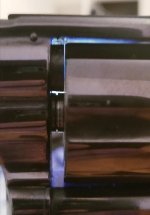Sittinduck21
Member
- Joined
- Apr 22, 2015
- Messages
- 35
- Reaction score
- 45
Hello, Gentlemen! I just bought a Model 19-3. I'm new to revolvers, and I was hoping you all could help me understand something. What is the minimum cylinder gap allowable on a Model 19 or any revolver for that matter? I did some googling, and the closest I came up with was 0.004" for GP100.
The gap on my revolver is barely visible. I couldn't find my feeler gauge, but I measured a piece of printer paper at 0.004" with my calipers and tried to slide it between the cylinder and the forcing cone. It didn't fit, not even a little.
What is the minimum gap between the cylinder and the forcing cone? Does the cylinder gap affect safety?
The gap on my revolver is barely visible. I couldn't find my feeler gauge, but I measured a piece of printer paper at 0.004" with my calipers and tried to slide it between the cylinder and the forcing cone. It didn't fit, not even a little.
What is the minimum gap between the cylinder and the forcing cone? Does the cylinder gap affect safety?
Attachments
Last edited:

